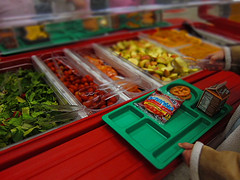According to the Natural Resources Defense Council, food production represents 10 percent of the total US energy budget, uses 50 percent of US land, and accounts for 80 percent of the freshwater we consume–yet, 40 percent of food in the US goes uneaten. And in 2013, 49.1 million Americans lived in food insecure households, including 33.3 million adults and 15.8 million children. Food waste is clearly both a tremendous problem and opportunity for improving the sustainability of our society. Reducing food waste in schools not only helps to ensure those precious expended resources are providing nutrition as intended, but also provides the opportunity to set important examples of conservation and systems thinking among our impressionable youth, which will hopefully stay with them as they become our next generation of leaders.
The Illinois Sustainable Technology Center (ISTC) is therefore pleased to announce an exciting new project that addresses this important societal and environmental challenge. In order to identify sources of food waste in K-12 schools and facilitate its prevention and reduction, ISTC, in collaboration with the Illinois State Board of Education (ISBE), UI Extension, and Beyond Green Partners, Inc., is launching the Green Lunchroom Challenge this fall. Funded by US EPA Region 5, the program is open for participation from K-12 schools throughout the state. Marketing of the program will however, be targeted toward underserved regions of southern Illinois, including Pulaski, Alexander, Marion, White, and Fayette counties. According to data from the ISBE, over 70 percent of K-12 students in those counties are eligible for assistance through the National School Lunch Program. By preventing and reducing food waste in these areas particularly, and throughout the state, it is hoped the Challenge will not only achieve environmental benefits, but also stretch federal and state assistance and resources through increased efficiency.

Similar to the successful Illinois Green Office Challenge, the Green Lunchroom Challenge is a voluntary, “friendly competition,” in which participating schools will choose among a variety of suggested activities to improve the sustainability of their food service. These activities will range in complexity and commitment to allow participants to best suit their situation, budget, and available community resources. Examples might include, but not be limited to, composting of food scraps, use of creative entree names and careful relative placement of food choices to reduce waste of fruit and vegetables, donation of unused food to local food banks or shelters, etc. In addition to operationally related activities, schools may also choose to integrate food waste prevention and reduction into curricula, helping students learn about food security and hunger, composting, the circular economy, and stewardship. Resources and guidance will be available on the project web site and from ISTC technical assistance staff for each recommended activity, and participants will earn points for every activity they complete. Relative progress will be displayed on an online leaderboard. On Earth Day 2016, the participating public K-12 school with the most points will be declared the winner for the year and will receive public recognition and a prize (to be determined) to foster continuous improvement.
A kickoff workshop will be held in September 2015 (date and location to be announced) to introduce the Challenge; identify (in part through feedback from school and district representatives in attendance) key sources of food waste in schools, as well as barriers to its prevention; to raise awareness among potential participants of existing relevant toolkits and programs; and to provide comprehensive training on analysis and modification of menus, food procurement and inventory, lunchroom procedures, etc. Note that a school does not need to participate in the workshop to participate in the Challenge, and schools may register throughout the Challenge period (Sept. 1, 2015- April 1, 2016). While the competition is only open to K-12 schools in Illinois, ISTC hopes that other states and organizations beyond schools will be able to use resources developed for the Challenge to guide food waste reduction and prevention in their operations and regions.
Interested parties may contact Joy Scrogum with questions or to request addition to the mailing list for more information on the workshop and activities as it becomes available. The project web site will be available soon, and potential participants will be able to sign up to receive further information there as well. (The URL for the program web site will be posted in the comments of this post as soon as it is live.)

This post was originally published on the ISTC Blog, July 7, 2015.
